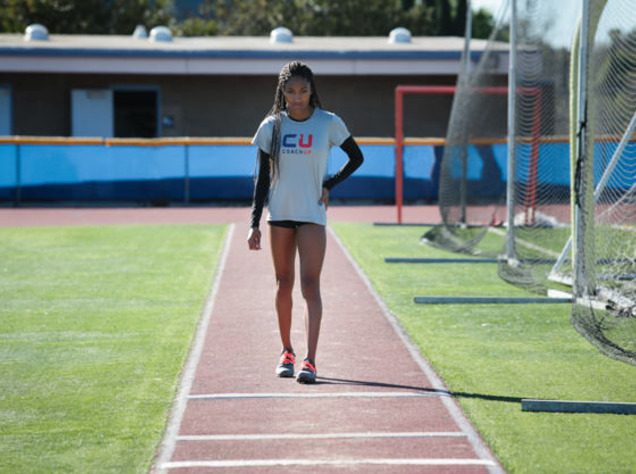The long jump is a difficult event that requires highly skilled athletes to combine strength, speed, and technique into brilliant split-second performances. However, it’s not as easy as a hop, skip, and a jump down the track — in fact, practicing the long jump takes some serious patience and dedication. It can be simply frustrating to set a personal record only to lose to a further jumper, so it’s crucially important to keep things in perspective at all times.
In addition, it’s particularly intriguing both mentally and physically because you’re just competing against yourself. There are no rivals to push you harder on the last turn, there are no final hurdles, or epic photo-finish endings — just you against the jump. So, how should you tackle it? What should you focus on the most? Well, the good news is that you can take these CoachUp tips you the next time you tackle the sand — use them to your advantage!
Ultimately, the best way to approach the long jump is by breaking it down into basic components and working on building up a strong, sturdy foundation in each. Then, once you’ve done that, they’ll all meld together in wonderful symphony and glory. What that being said, here are the four technical components of the long jump:

Approach
In order to be successful in your jump, you’ll want to hit the takeoff board at your absolute top speed. However, it cannot be overstated that hitting the takeoff board at the correct moment is also immensely important. When you see long jumpers perform, their strides towards the board may seem bizarre. Most are longer than sprinter’s strides and there is a reason for that. Long jumpers develop a rhythm based off the number of strides they know they need in order to reach the takeoff board as fast and efficiently as possible. For most adult athletes, the number of strides is around twenty-one.
So, get out there and figure out what works for you! What feels the most natural? What feels right? Which amount feels wrong? These are all questions that long jumpers must ask themselves before liftoff. If you can’t hit the board at your top speed, your performance will suffer. And if you can’t hit top speed because of an uncomfortable stance or routine, your performance will suffer as well. Basically, the majority of the long jump breaks down to comfortability and rhythm, so make sure you aren’t throwing it by the wayside. Once you’ve got routine, rhythm, and muscle memory on your side, you’ll be find to move onto what’s next!
Takeoff
First and foremost, you should focus on getting your foot positioned correctly on the takeoff board during the last few strides. Again, this is rhythm you’re working towards creating. Additionally, you want to make sure you don’t step over the foul line and get disqualified, then you’re just hurting yourself more than a below-average jump would. Right before you take your last stride, sink your hips and then raise them as you takeoff. Your weight should be slightly shifted back with your hips located in front of your shoulders. Generally speaking, right-handed athletes use their left foot to jump off and vice versa. However, some people are comfortable using their dominant foot to jump off so personal preference takes precedent in this case.
As always, in case it hasn’t been made very obvious yet, comfortability and rhythm rule all — so, don’t pigeon-hole yourself into a stance, stride, or takeoff technique that doesn’t feel right. It might take some trial and error, but pay attention to your body and what it tells you during the takeoff, then do whatever feels right!
Flight
Most casual long jump observers might think that the time spent in the air to be largely unimportant for the overall distance of the attempt, but this is a misguided view. In fact, the importance of the flight cannot be stressed enough as it’s entirely essential for high distances and personal records. If you watch top long jump athletes compete, you’ll see that they keep their body momentum moving towards the goal without bringing their upper body forward. This key positioning prevents their feet from hitting the sand early — remember, you want to milk as much as you can out of each and every inch.
Landing
Of course, the long jump distance is measured from the first spot your body touches the sand at. Of course, this means that your other body parts count as well, so long as they’re behind your feet. This infers that you cannot let your buttocks or hands hit the sand before your feet — this will set you back at a further distance. It’s important to stretch your feet out in front of you before contact to set yourself up for a solid distance. Your body should be landing in a diagonal shape towards the ground with your feet farther out in front of the rest of your limbs.
(Related: Read about utilizing your speed as a skill here.)
Huddle Up
The long jump is always an exciting event to watch because of how quickly it happens. The sheer speed of the athletes who participate in the long jump is astonishing; and the distance covered while airborne is not something to be taken lightly, either. For new jumpers, the long jump can be rough and difficult, but stick with it. If you’re still struggling with any of these aspects, consider booking one of CoachUp’s private instructors to help you out along the way. They’ll have you crushing your personal record in no time, so what are you waiting for?
Be prepared for the biggest moments by mastering the small ones off the track.
How useful was this post?
Click on a star to rate it!
Average rating 3.8 / 5. Vote count: 12
No votes so far! Be the first to rate this post.




One Response
Keep up this amazing work! I enjoyed reading it